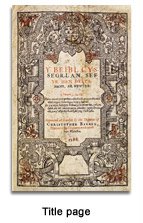A Bible For Wales
 The year 1588 saw the publication of the first Welsh translation of the complete Bible, including the Apocrypha. It was the work of William Morgan, 1545-1604, a native of Penmachno, Conwy and a graduate of St. John's College, Cambridge. This folio volume was printed in black letter by the deputies of Christopher Barker, the Queen's Printer. It was intended for church rather than home use. At the time of the Acts of Union (1536 and 1542), few Welshmen or women could have foreseen the publication of a Welsh Bible before the end of the century. Several factors made this unlikely. Welsh had been denied official status and had been banned from the spheres of law and administration. Furthermore it had been decreed that the English Bible and Book of Common Prayer were to be read in every church in the land. The bardic order, the traditional guardian of the literary language, was also in decline. It was probable that the language would deteriorate into a despised collection of dialects and eventually die. The fact that it did not do so is largely due to the efforts of a group of Welsh scholars imbued with enthusiasm for the humanistic learning of the Renaissance. Most were Protestants driven by a Protestant zeal for making the Scriptures available to all. Men steeped in classical learning, they also dreamt of seeing the vernacular safeguarded and elevated to the status of a learned language. Their dictionaries, grammars, and scriptural translations, of which the 1588 Bible is the supreme example, went far to turn this dream into reality.
The year 1588 saw the publication of the first Welsh translation of the complete Bible, including the Apocrypha. It was the work of William Morgan, 1545-1604, a native of Penmachno, Conwy and a graduate of St. John's College, Cambridge. This folio volume was printed in black letter by the deputies of Christopher Barker, the Queen's Printer. It was intended for church rather than home use. At the time of the Acts of Union (1536 and 1542), few Welshmen or women could have foreseen the publication of a Welsh Bible before the end of the century. Several factors made this unlikely. Welsh had been denied official status and had been banned from the spheres of law and administration. Furthermore it had been decreed that the English Bible and Book of Common Prayer were to be read in every church in the land. The bardic order, the traditional guardian of the literary language, was also in decline. It was probable that the language would deteriorate into a despised collection of dialects and eventually die. The fact that it did not do so is largely due to the efforts of a group of Welsh scholars imbued with enthusiasm for the humanistic learning of the Renaissance. Most were Protestants driven by a Protestant zeal for making the Scriptures available to all. Men steeped in classical learning, they also dreamt of seeing the vernacular safeguarded and elevated to the status of a learned language. Their dictionaries, grammars, and scriptural translations, of which the 1588 Bible is the supreme example, went far to turn this dream into reality.You may view a digital facsimile copy here.
